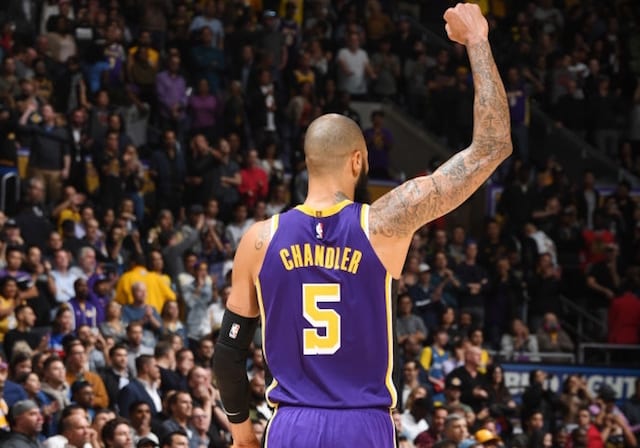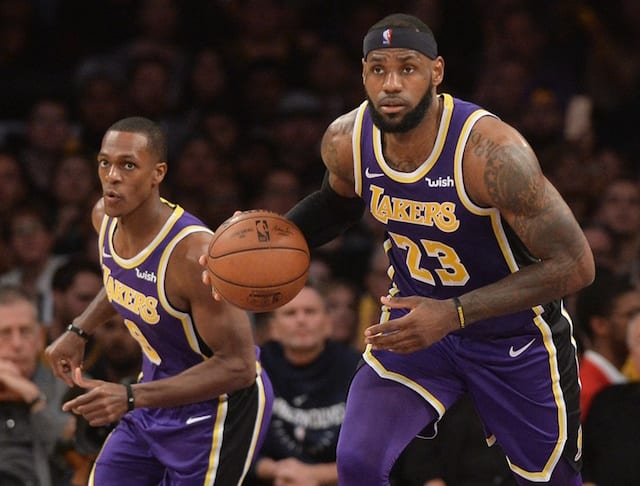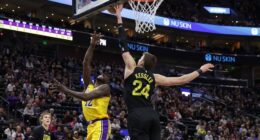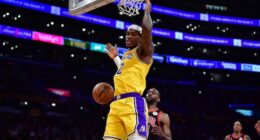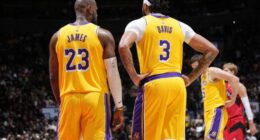The Los Angeles Lakers are evolving, or perhaps devolving, right before our eyes, and it might not be a bad thing. The modern NBA is all about space and pace as teams strive to field a team full of versatile, switchy players who can shoot, pass, defend, create and rebound.
Plodding big men who can’t shoot are left in the dust as teams zip up and down the floor in the name of progress. Despite a more forward-thinking approaching under president of basketball operations Magic Johnson and general manager Rob Pelinka, the Lakers have moved slightly away from that model, and it’s the recent addition of Tyson Chandler that’s allowed them to do so.
Of course, that wasn’t the plan going into the season.
Johnson and Pelinka did a curious thing this past summer when building the roster. The franchise that has featured some of the all-time great big men in NBA history, with names like Chamberlain, O’Neal, Mikan, and Abdul-Jabbar in their rafters, spent less money on the center position than any team in the league.
They decided that a center rotation built around JaVale McGee, Ivica Zubac and Moritz Wagner was enough to get by, with the argument being that some of the top teams in the playoffs, like the Houston Rockets and Golden State Warriors, weren’t playing traditional centers in their second unit anyway.
All that was needed was someone to chew up some minutes here and there, rebound, blocks some shots, and then a small-ball lineup would take over to close out the game.
Well, it didn’t take long for the Lakers to realize they were wrong, or at least, wrong in their belief that their roster was designed to dive head-first into the small-ball revolution with no safety net.
Teams that go small do so not because it’s a magical formula that turns them into juggernauts, but because it’s a bet that puts the odds in their favor. Going small, with a player like say power forward Kyle Kuzma at center, is a wager that the offensive benefit that player brings in spacing, shooting, and speed will outweigh the points they surrender due to a decrease in rebounding and rim protection.
This worked for the Rockets because they have the three-point shooting to win the war of attrition. You might score a bucket on them in the paint for two points but they are going to get three the next trip down, either from behind the arc or when James Harden uses the extra space to head-flail his way into an and-one.
Trade three for two enough and you win, especially if your defense can scheme a way to mitigate the points allowed by a small lineup.
The Warriors, on the other hand, pull it off with a combination of shooting and the fact that they have an undersized, versatile big in Draymond Green who can do a little of everything, including protect the paint at a level comparable to a traditional center.
This is the tactic the Lakers employed last year using Julius Randle, whose bruising strength allowed him to hold his own in the post while his ball handling and speed made the Lakers a more dangerous transition team then when they used the lumbering but effective Brook Lopez at the five.
The Lakers went into this season believing that going small would again be their path to success, and as such, they weren’t concerned with the facts that McGee had barely averaged 10 minutes per game over his four previous NBA seasons, Zubac was a huge question mark after a disappointing sophomore campaign, and Wagner an untested rookie.
Whatever minutes the trio of bigs could provide would only need to hold them over until they could press down on the turbo button by going small once again.
The problem was that Randle, the 250-pound bulldozer who was the lynchpin of the small-ball lineups last season, wasn’t brought back. Nor was Lopez, the rebounding-allergic center who focuses on boxing out, which allowed Lakers guards to grab and go on the boards.
Instead, they asked the 220-pound Kuzma, who is closer to being a small forward than a center, to fill the role. In a surprise to few, Kuzma struggled to adapt on either end of the floor. The team was hemorrhaging points and rebounds while not scoring enough on the other end to make up for it.
The small ball gamble wasn’t paying off and the team was losing.
Kuzma was one of the bright spots last season and arguably the steal of the 2017 NBA Draft with the 27th pick. It’s imperative for the future that the Lakers get the best out of him, and that clearly wasn’t going to happen at the five.
The team tried to toss Zubac some minutes and briefly found something in undrafted rookie Johnathan Williams, but neither provided the polish that was needed in order to be a long-term solution. This led to McGee playing more than anyone was comfortable with, including a 35-minute stint against the Dallas Mavericks. McGee has been excellent but having him play that many minutes isn’t sustainable.
With Zubac still struggling and Wagner recovering from a knee injury picked up in Summer League, the Lakers weakness in the middle was becoming a problem. Their Defensive Rating sat at 23rd in the league and their rebound percentage was in the bottom third.
There were plenty of issues coming into play, including the fact that the team needed more time to become familiar with each other after bringing in a horde of new faces, but the weakness in the middle was glaring. When McGee was on the bench, the Lakers were toast.
Magically, veteran big man Tyson Chandler was bought out by the Phoenix Suns, possibly because James called in a favor from Suns interim general manager James Jones, if you believe that sort of thing. Chandler swiftly signed with the Lakers, and three games into his stint, the results have been impressive.
The small-ball idea, with Kuzma at center, has clearly been shelved. In the four games since signing Chandler, the Lakers have played a total of three minutes without a traditional center on the floor. Both McGee and Chandler employ a similar style, which allows the Lakers to maintain continuity between their first and second units.
McGee’s springs make him the better lob target while Chandler’s bone-crushing (and sometimes illegal) screens free the team’s ball handlers, but the bottom line is that both bigs focus on the dirty work of rebounding, rim protecting, and no-frills finishing at the rim. Lakers players, whether they are starting or coming off the bench, now know they will have an anchor behind them at the rim and it has made a world of difference.
Since the arrival of Chandler, the Lakers have had the third-best defensive rating in the league and their rebounding percentage has jumped all the way up to sixth. While the small sample size certainly throws off the reliability of that ranking, it’s still clear that running a traditional big at all times has been a major success thus far.
Case in point, against a small-ball lineup Trae Young’s buzzer-beating finger roll last Sunday night probably goes in and the Lakers would be left to lament losing to the lowly Atlanta Hawks. Instead, they celebrated a game-saving block by Chandler.
Small ball just may be the wave of the future, but only if the team is constructed in a way that the gamble has a high chance of paying off. Credit the Lakers for recognizing that the odds were not in their favor, swallowing their pride, and making the necessary changes to put themselves back in a position to win.
